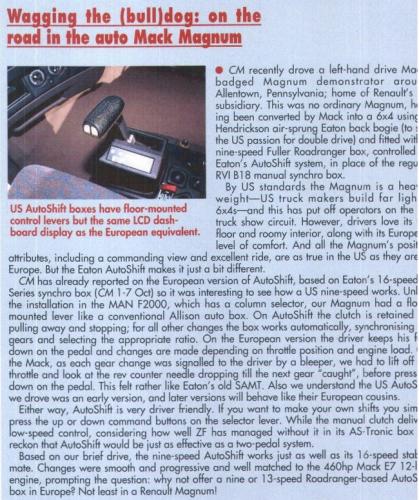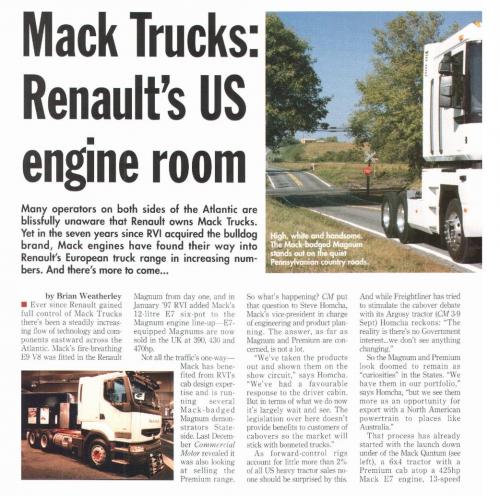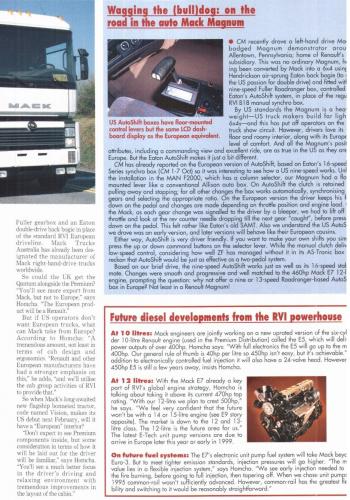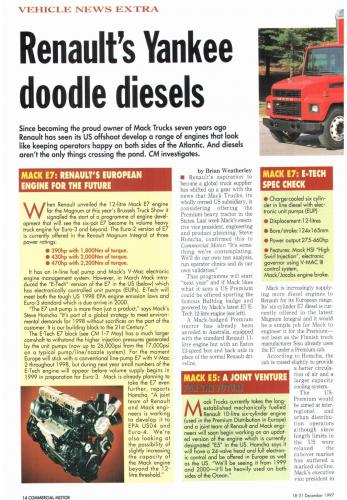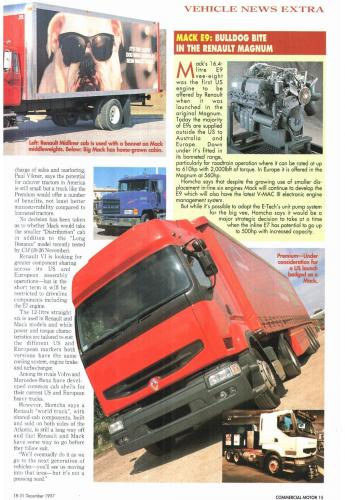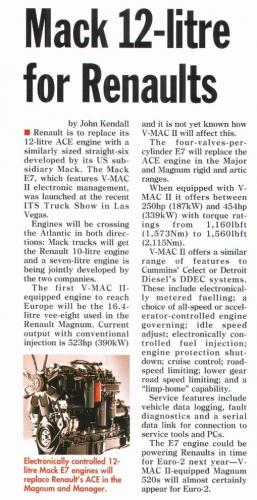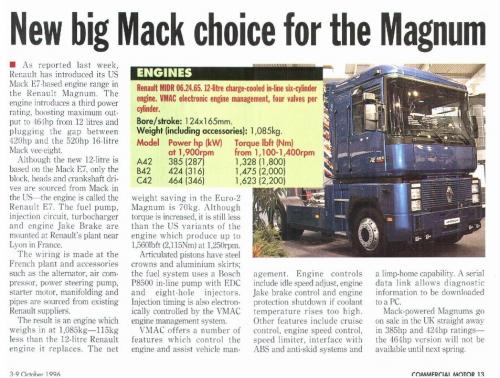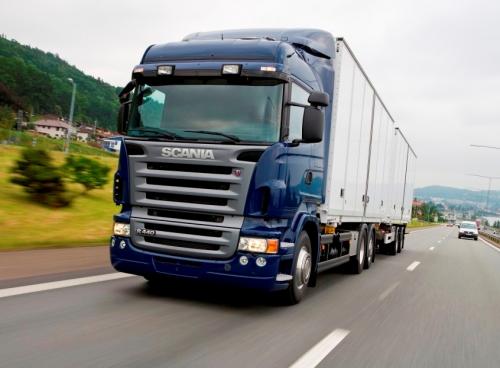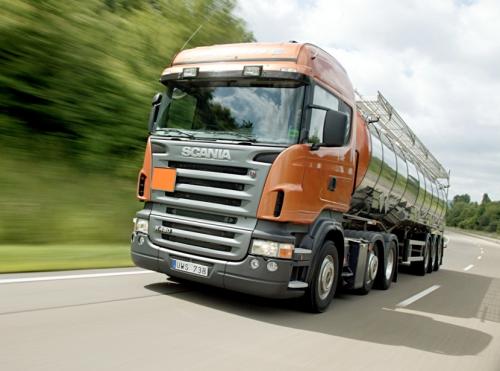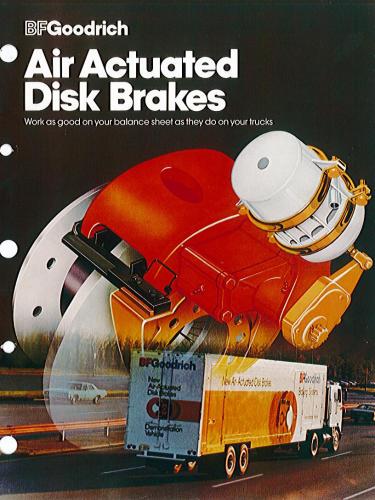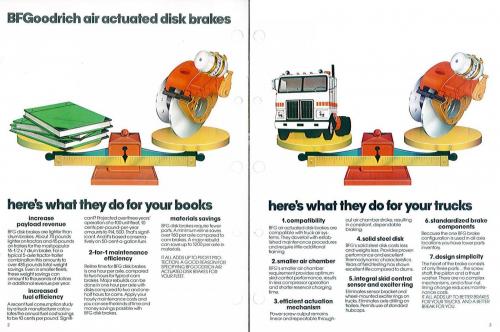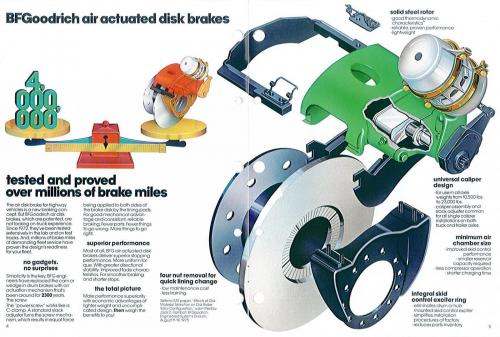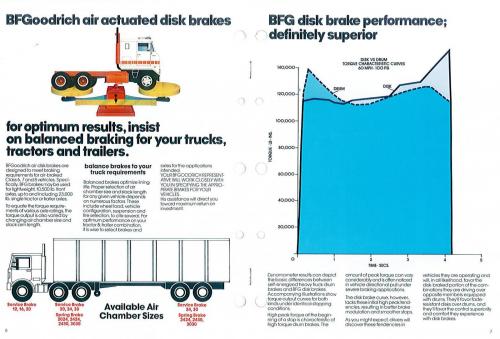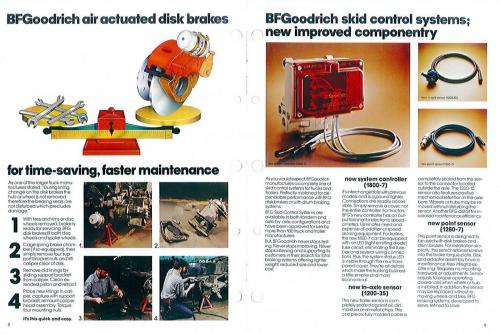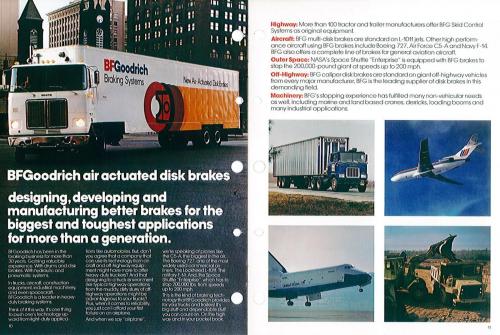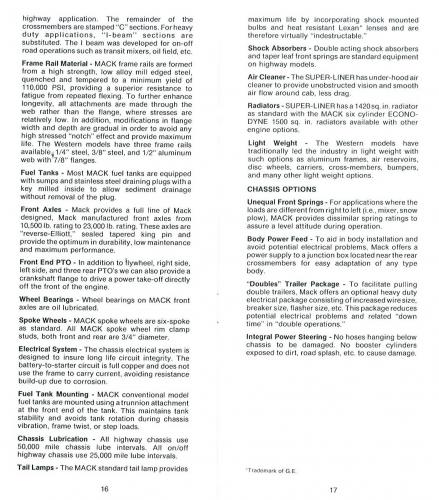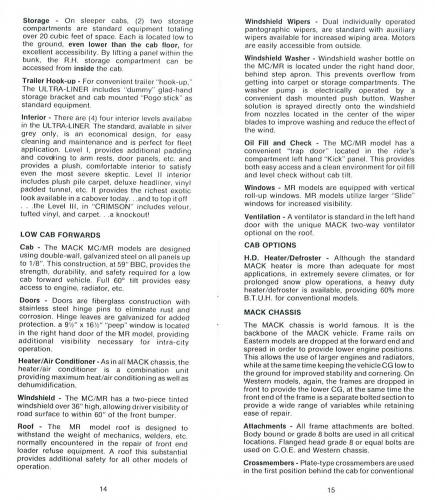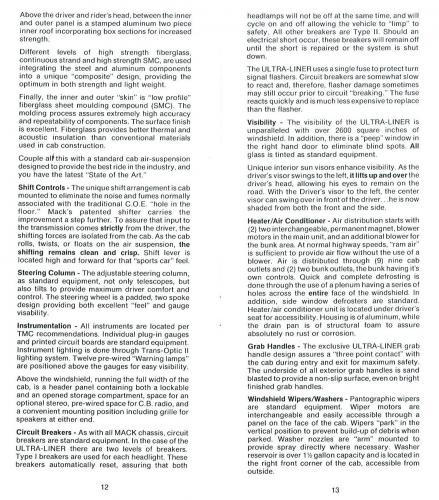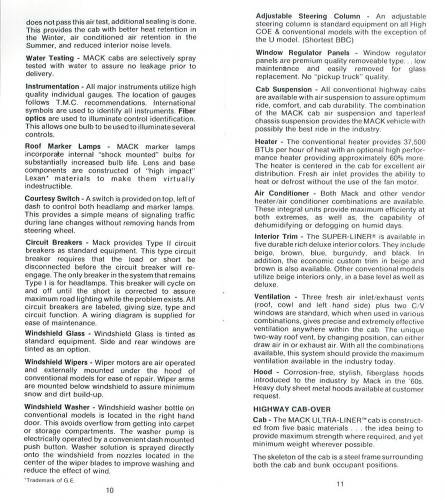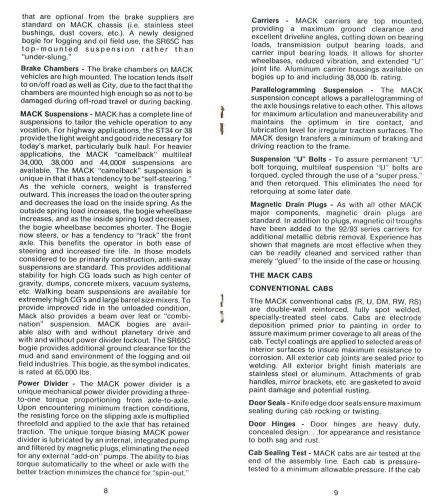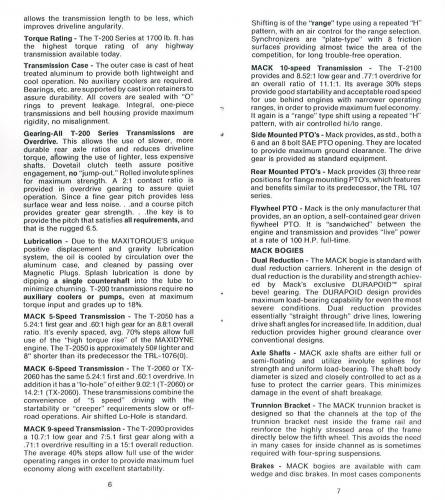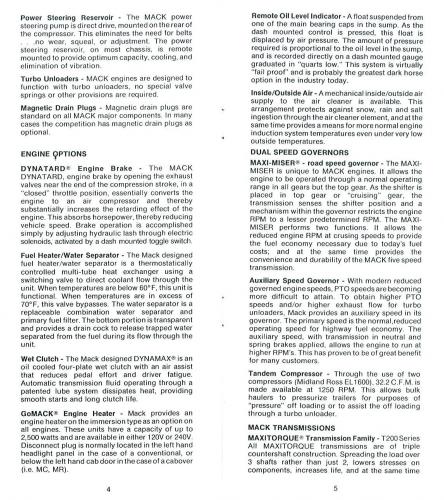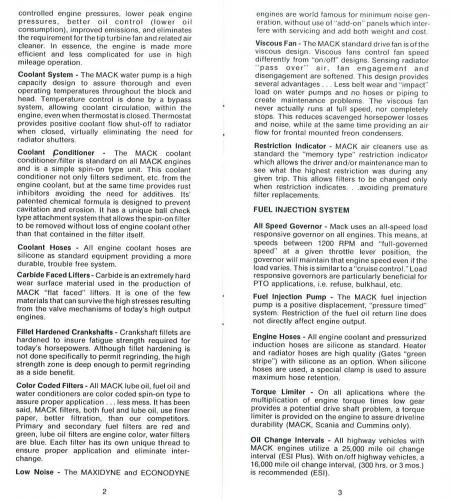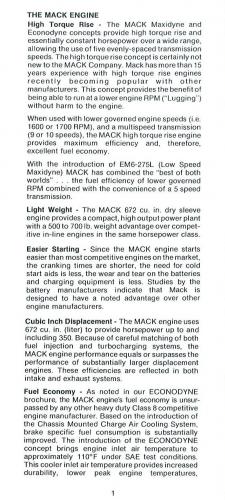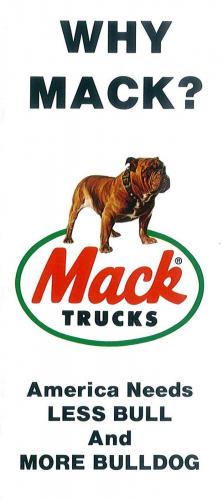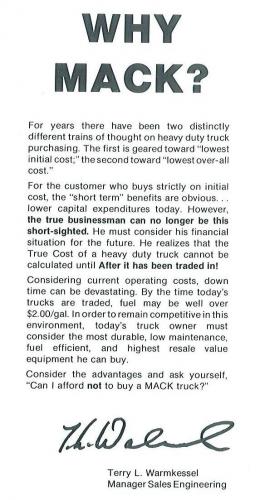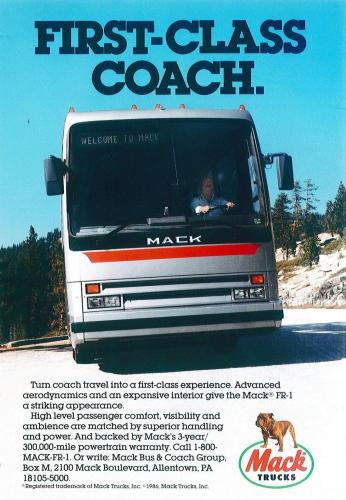
kscarbel2
Moderator-
Posts
17,802 -
Joined
-
Days Won
85
Content Type
Profiles
Forums
Gallery
Events
Blogs
BMT Wiki
Collections
Store
Everything posted by kscarbel2
-
Wagging the (bull)dog: on the road in the auto Mack Magnum
kscarbel2 posted a topic in Trucking News
Commercial Motor / October 22, 1998 Commercial Motor recently drove a left-hand drive Mack-badged Magnum demonstrator around Allentown, Pennsylvania; home of Renault's subsidiary. This was no ordinary Magnum, having been converted by Mack into a 6x4 using a Hendrickson air-sprung Eaton rear bogie (to the US passion for double drive) and fitted with a nine-speed Eaton AutoShift automated manual transmission (AMT) in place of the regular RVI B18 synchronized manual box. By US standards the Magnum is a heavyweight, US truckmakers build far lighter 6x4s, and this has put off operators on the truck show circuit. However, drivers love its flat floor interior and roomy interior, along with its European level of comfort. And all the Magnum's positive attributes, including a commanding view and excellent ride, are as true in the US as they are in Europe. But the Eaton AutoShift makes it just a bit different. Commercial Motor has already reported on the European version of AutoShift, based on Eaton's 16-speed synchronized manual box, so it was interesting to see how a US market 9-speed AutoShift works. As in the installation in the MAN F2000, which has a column selector, our Magnum had a floor mounted lever like a conventional Allison auto box. On AutoShift, the clutch is retained for pulling away and stopping; for all other changes the box works automatically, synchronizing gears and selecting the appropriate ratio. On the European version, the driver keeps his foot on the pedal and changes are made depending on throttle position and engine load. In the Mack, as each gear change was signalled to the driver by a bleeper, we had to lift off throttle and look at the rev counter needle dropping till the next gear 'caught", before pressing down on the pedal. This felt rather like Eaton's old SAMT. Also we understand the US AutoShift we drove was an early version, and later versions will behave like their European cousins. Either way, AutoShift is very driver friendly. If you want to make your own shifts, you simply press the up or down command buttons on the selector lever. While the manual clutch delivers low-speed control, considering how well ZF has managed without it in its AS-Tronic box, we reckon that AutoShift would be just as effective as a two-pedal system. Based on our brief drive, the 9-speed AutoShift works just as well as its 16-speed stablemate. Changes were smooth and progressive, and well matched to the 460hp Mack E7 12litre engine, prompting the question: why not offer a 9- or 13-speed Roadranger-based AutoShift box in Europe? Not the least in a Renault Magnum! -
Commercial Motor / October 22, 1998 Many operators on both sides of the Atlantic are blissfully unaware that Renault owns Mack Trucks. Yet in the seven years since RVI acquired the bulldog brand, Mack engines have found their way into Renault's European truck range in increasing numbers. And there's more to come. Ever since Renault gained full control of Mack Trucks, there's been a steadily increasing flow of technology and components eastward across the Atlantic. Mack's fire-breathing E9 V-8 was fitted in the Renault Magnum from day one, and in January '97 RVI added Mack's 12-litre E7 six-pot to the Magnum engine line-up—E7equipped Magnums are now sold in the UK at 390, 430 and 470hp. Not all the traffic's one-way— Mack has benefited from RVI's cab design expertise and is running several Mack-badged Magnum demonstrators Stateside. Last December, Commercial Motor revealed it was also looking at selling the Premium range. So what's happening? Commercial Motor put that question to Steve Homcha, Mack's vice-president in charge of engineering and product planning. The answer, as far as Magnum and Premium are concerned, is not a lot. "We've taken the products out and shown them on the show circuit," says Homcha. "We've had a favourable response to the driver cabin. But in terms of what we do now, it's largely wait and see. The legislation over here doesn't provide benefits to customers of cabovers so the market will stick with bonneted trucks." As forward-control rigs account for little more than 2% of all US heavy tractor sales noone should be surprised by this. And while Freightliner has tried to stimulate the cabover debate with its Argosy tractor, Homcha reckons: "The reality is there's no government interest (in revising the weight laws), we don't see anything changing." So the Magnum and Premium look doomed to remain as "curiosities" in the States. "We have them in our portfolio." says Homcha, "but we see them more as an opportunity for export with a North American powertrain to places like Australia." That process has already started with the launch down under of the Mack Qantum, a 6x4 tractor with a Premium cab atop a 425hp Mack E7 engine, 13-speed Fuller gearbox and an Eaton double-drive back bogie in place of the standard RVI European driveline. Mack Trucks Australia has already been designated the manufacturer of Mack right-hand-drive trucks worldwide. So could the UK get the Qantum alongside the Premium? "You'll see more export from Mack, but not to Europe," says Homcha. "The European product will be a Renault," But if US operators don't want European trucks, what can Mack take from Europe? According to Homcha: "A tremendous amount, not least in terms of cab design and ergonomics. "Renault and other European manufacturers have had a stronger emphasis on this," he adds, "and we'll utilize the cab group activities of RVI to provide that." So when Mack's long-awaited new flagship bonneted tractor, code named Vision, makes its US debut next February, will it have a "European" interior? "Don't expect to see premium components inside, but some consideration in terms of how it will be laid out for the driver will be familiar," says Homcha. "You'll see a much better focus in the driver's driving and relaxing environment with tremendous improvements in the layout of the cabin."
-
Commercial Motor / December 18, 1997 Since becoming the proud owner of Mack Trucks seven years ago, Renault has seen its US offshoot develop a range of engines that are keeping operators happy on both sides of the Atlantic. And diesels aren't the only things crossing the pond. Renault's aspiration to become a global truck supplier has shifted up a gear with the news that Mack Trucks, its wholly owned US subsidiary, is considering offering the Premium heavy tractor in the States. Last week Mack's executive vice president, engineering and product planning, Steve Homcha, confirmed this to Commercial Motor: "It's something we're contemplating. We'll do our own test analysis, run operator clinics and do our own validation." That program will start "next year" and if Mack likes what it sees a US Premium could be offered sporting the famous Bulldog badge and powered by Mack's latest E7 E-Tech 12-litre engine. A Mack-badged Premium tractor has already been unveiled in Australia, equipped with the standard Renault 11 litre engine but with an Eaton 13-speed box and drive axles in place of the normal Renault driveline. Mack is increasingly supplying more diesel engines to Renault for its European range. Its' six-cylinder E7 diesel is currently offered in the latest Magnum Integral and it would be a simple job for Mack to engineer it for the Premium— not least as the Finnish truck manufacturer Sisu already uses the E7 under a Premium cab. According to Homcha, the cab is raised slightly to provide a better circulation of air and a larger capacity cooling system. The US market Premium would be aimed at inter-regional and urban distribution operators although since length limits in the US were relaxed, the cabover market has suffered a marked decline. Mack's executive vice president in charge of sales and marketing, Paul Vikner, says the potential for cabover tractors in America is still small but a truck like the Premium would offer a number of benefits, not least better maneuverability compared to bonneted tractors. No decision has been taken as to whether Mack would take the smaller "Distribution" cab in addition to the "Long Distance" model. Renault (RVI) is looking for greater component sharing across its US and European assembly operations—but in the short term it will be restricted to driveline components including the E7 engine. The 12-litre straight six is used in Renault and Mack models and, while power and torque characteristics are tailored to suit the different US and European markets, both versions have the same cooling system, engine brake and turbocharger. Among its rivals, Volvo and Mercedes-Benz have developed common cab shells for their current US and European heavy trucks. However, Homcha says a Renault "world truck", with shared cab components, built and sold on both sides of the Atlantic, is still a long way off and that Renault and Mack have some way to go before they follow suit. "We'll eventually do it as we go to the next generation of vehicles—you'll see us moving into that area—but it's not a pressing need." MACK E7: RENAULT'S EUROPEAN ENGINE FOR THE FUTURE When Renault unveiled the 12-litre Mack E7 engine for the Magnum at this year's Brussels Truck Show, it signalled the start of a program of engine development that will see the six-pot E7 become its volume heavy truck engine for Euro-3 and beyond. The Euro-2 version of E7 is currently offered in the Renault Magnum Integral at three power ratings: • 390hp with 1,800Nm of torque • 430hp with 2,000Nm of torque • 470hp with 2,200Nm of torque It has an in-line fuel pump and Mack's V-Mac electronic engine management system. However, in March, Mack introduced the "E-Tech" version of the E7 in the US market, which has electronically controlled unit pumps (EUPs). E-Tech will meet both the tough US 1998 EPA engine emission laws and Euro-3 standard which is due arrive in 2000. "The E7 unit pump is more than just a product," says Mack's Steve Homcha "It's part of a global strategy to meet environmental demands for 1998 without sacrifices on the part of the customer. It is our building block to the 21st Century." The E-Tech E7 block has a much larger camshaft to withstand the higher injection pressures generated by the unit pumps (now up to 26,000psi from the 17,000psi on a typical pump/line/nozzle system). For the moment, Europe will stick with a conventional in-line pump E7 with V-Mac 2 throughout 1998, but during next year small numbers of the E-Tech engine will appear before volume supply begins in 1999 in preparation for Euro-3. Mack is already planning to take the E7 even further, reports Homcha. "A joint team of Renault and Mack engineers is working to develop it to EPA 2004 and Euro-4. We're also looking at the possibility of slightly increasing the capacity of the Mack engine beyond the 12 litre threshold." MACK E7: E-TECH SPECS • Charge-cooled six cylinder in line diesel with electronic unit pumps (EUP) • Displacement:12-litres • Bore/stroke:124x165mm • Power output:275-460hp • Features: Mack HSI "High Swirl Injection", electronic governor using V-MAC III control system, Mack/Jacobs engine brake. MACK E9: BULLDOG BITE IN THE RENAULT MAGNUM Mack's 16,4 litre E9 V-8 was the first US engine to be offered by Renault when it was launched in the original Magnum. Today, the majority of E9s are supplied outside the US to Australia and Europe. Down under it's fitted in its bonneted range, particularly for roadtrain operation where it can be rated at up to 610hp with 2,050 lb/ft (2,779N.m) of torque, In Europe, it is offered in the Magnum at 560hp. Homcha says that despite the growing use of smaller displacement in-line six engines, Mack will continue to develop the E9 which will also have the latest V-MAC III electronic engine management system. But while it's possible to adapt the E-Tech's unit pump system for the big V-8, Homcha says it would be a major strategic decision to take at a time when the in-line E7 has potential to go up to 500hp with increased capacity. Mack Trucks currently takes the long established mechanically fuelled Renault 10-litre six-cylinder engine (used in the Premium Distribution in Europe) and a joint team of Renault and Mack engineers will soon begin working on an updated version of the engine which is currently designated "E5" in the US. Homcha says it will have a 24-valve head and full electronic control and be offered in Europe as well as the US. "We'll be seeing it from 1999 and 2000—it'll be heavily used on both sides of the Ocean." .
-
Commercial Motor / July 6, 1995 Renault is to replace its 12-litre ACE engine with a similarly sized straight-six developed by its US subsidiary Mack. The Mack E7, which features V-MAC II electronic management, was launched at the recent ITS Truck Show in Las Vegas. Engines will be crossing the Atlantic in both directions: Mack trucks will get the Renault 10-litre engine and a seven-litre engine is being jointly developed by the two companies. The first V-MAC IIequipped engine to reach Europe will be the 16.4litre vee-eight used in the Renault Magnum. Current output with conventional injection is 523hp (390kW) and it is not yet known how V-MAC ll will affect this. The four-valves-per-cylinder E7 will replace the ACE engine in the Major and Magnum rigid and artic ranges. When equipped with VMAC II it offers between 250hp (187kW) and 454hp (339kW) with torque ratings from 1,160Ibft (1,573Nm) to 1,560Ibft (2,115Nm). V-MAC II offers a similar range of features to Cummins' Celect or Detroit Diesel's DDEC systems. These include electronically metered fuelling; a choice of all-speed or accelerator-controlled engine governing; idle speed adjust; electronically controlled fuel injection; engine protection shutdown; cruise control; roadspeed limiting; lower gear road speed limiting; and a "limp-home" capability. Service features include vehicle data logging, fault diagnostics and a serial data link for connection to service tools and PCs. The E7 engine could be powering Renaults in time for Euro-2 next year—VMAC II-equipped Magnum 520s will almost certainly appear for Euro-2. .
-
Commercial Motor / October 3, 1996 As reported last week, Renault has introduced its US Mack E7-hased engine range in the Renault Magnum, The engine introduces a third power rating, boosting maximum output to 464hp from 12 litres and plugging the gap between 420hp and the 520hp 16-litre Mack vee-eight. Although the new 12-litre is based on the Mack E7, only the block, heads and crankshaft drives are sourced from Mack in the US—the engine is called the Renault E7. The fuel pump, injection circuit, turbocharger and engine Jake Brake are mounted at Renault's plant near Lyon in France. The wiring is made at the French plant and accessories such as the alternator, air compressor, power steering pump, starter motor, man ifolding and pipes are sourced from existing Renault supplier. The result is an engine which weighs in at 1,085kg, 115kg less than the 12-litre Renault engine it replaces. The net weight saving in the Euro-2 Magnum is 70kg. Although torque is increased, it is still less than the US variants of the engine which produce up to 1,560lb.ft. (2,115Nm) at 1250rpm. Articulated pistons have steel crowns and aluminium skirts; the fuel system uses a Bosch P8500 in-line pump with EDC and eight-hole injectors. Injection timing is also electronically controlled by the VMAC engine management system. VMAC offers a number of features which control the engine and assist vehicle management. Engine controls include idle speed adjust, engine Jake brake control and engine protection shutdown if coolant temperature rises too high. Other features include cruise control, engine speed control, speed limiter, interface with ABS and anti-skid systems and a limp-home capability. A serial data link allows diagnostic information to be downloaded to a PC. Mack-powered Magnums go on sale in the UK straight away in 385hp and 424hp ratings— the 464hp version will not be available until next spring. .
-
NACFE report lays out 6x2 axle advantages and drawbacks
kscarbel2 replied to kscarbel2's topic in Trucking News
The 6x2 isn't for everyone. But having said that, speaking of snow belt use, the 6x2 is profitably, effectively and safely used in northern climates throughout Western and Eastern Europe, and China. The US market steerable pusher axle as you know it is a primitive beast compared to the modern designs offered by Scania and others. -
NACFE report lays out 6x2 axle advantages and drawbacks
kscarbel2 replied to kscarbel2's topic in Trucking News
Typical with a Scania, there is no excessive tire wear with a 6x2 configuration. You're running a steerable pusher axle (steering in unison with the steer axle via a draglink), or a liftable tag axle. It's a professionally engineered arrangement delivering superb results. . -
NACFE report lays out 6x2 axle advantages and drawbacks
kscarbel2 replied to kscarbel2's topic in Trucking News
Roeth noted that .......6x2 axle packages cost on average $1,000 to $2,000 more than the 6x4 variant largely due to their small production volumes as only 2.3% of all new Class 8 sleeper trucks built in 2013 came equipped in 6x2 configuration. It's unbelievable that the 6x2 is priced higher than a 6x4 in America. In Europe and elsewhere around the globe, the 6x2 is of course cheaper to purchase (and operate). To blame it on low volume is ridiculous. To ultimately achieve volume sales, you have to launch with the appropriate price for a 6x2 (with savings over the 6x4), accepting reduced profits in the beginning. -
Fleet Owner / January 21, 2013 An exhaustive review of 10 different data sets in a new report issued by the North American Council for Freight Efficiency (NACFE) this week finds that a 6x2 axle configuration can on average improve Class 8 sleeper tractor fuel economy by 2.5% versus a traditional 6x4 setup, with a 20 month payback period required to offset the higher initial cost of the 6x2 package. “We have medium to high confidence in these findings due to all the testing,” Mike Roeth, NACFE’s executive director, explained to Fleet Owner in an interview. “That’s in part because none of the 10 sets of data we examined have been published to our knowledge.” Roeth noted that “data sets” included: two 6x2 axle truck tests conducted by axle builders; two conducted by truck OEMs; five fleets test; and three by NACFE using Society of Automotive Engineer (SAE) fuel economy test parameters. “It’s very hard to test trucks because so many different variables are involved: weather, geography, temperature, load weight, etc.,” he pointed out. “That’s one reason why we believe the more data sets we can obtain about a particular technology, the better the analysis we can conduct. A lot of fleets test products but keep the results to themselves. We want to try and get more of them to share that in a non-competitive environment.” For example, Roeth noted that NACFE’s research indicated that 6x2 axle packages cost on average $1,000 to $2,000 more than the 6x4 variant largely due to their small production volumes as only 2.3% of all new Class 8 sleeper trucks built in 2013 came equipped in 6x2 configuration. “So if the confidence in the technology can be increased and more 6x2 configurations sold, that will drive down the price and improve resale values,” he explained. “That in turn helps those fleets already investing in 6x2 packages; thus they benefit from sharing their test data.” NACFE’s goal is also to provide a “warts-and-all” view of potential fuel saving technologies, so fleets get a more straightforward look at potential trade-offs. “In the case of 6x2s, there are several,” Roeth said. “Weight is lowered by 400 lbs. on average compared to a 6x4 but purchase price on the 6x2 is as noted before $1,000 to $2,000 higher. There is less mechanical maintenance needed on 6x2s compared to 6x4s but higher electronics service is need. That is because electronic load shifting technology helps mitigate traction losses in 6x2 configurations and we recommend that be spec'd for the 6x2 package.” Indeed, the potential loss of traction is the number one issue turning fleets off from 6x2 axle packages despite the fuel savings potential, he pointed out. “But we’ve found in our study that electronic load shifting systems, and even manual air-dump valves, can mitigate much of that traction issue,” Roeth said. "The science says you cannot equal 6x4 traction with a 6x2 package but you can get pretty close with load-shifting systems.” Finally, NACFE found that tire wear is much higher in 6x2 configurations versus 6x4 setups, on average resulting in $466 more in tire wear costs per year. “We will always address challenges and drawbacks of particular fuel-saving technologies in our reports,” Roeth stressed. “We need to provide fleets with a complete picture. But the more test data we can get about particular products, the more confidence we can provide to the industry in temrs of the fuel saving results. Video: http://fleetowner.com/equipment/nacfe-report-lays-out-6x2-axle-advantages-and-drawbacks
-
When B.F. Goodrich introduced disc brakes to the North American heavy truck market in 1978, weight sensitive haulers welcomed the weight savings over conventional drum brakes. However, shorter than expected brake pad life dampened customer's initial encounter with the new technology. Of course today, proven in Europe, disc brakes are accepted as the best braking technology. .
-
-
-
-
-
-
-
-
-
-
-
Navistar Makes LED Headlights Standard on ProStars
kscarbel2 replied to kscarbel2's topic in Trucking News
Actually, the license-built MAN D20 and D26 engines (Maxxforce 11 and 13) are exceptionally good engines. They suffered at the hands of Navistar when the company attempted to meet EPA2010 using what is called Massive EGR (MEGR) - EGR levels from 35% to 50%. These MAN engines performed superbly with EGR in Euro-5 spec, but MAN realized the limitations of today's technologies and switched to SCR for Euro-6 (the near equivalent of EPA2010). It was an arrogant Dan Ustian that thought he could be smarter than the Germans that actually designed these engines and meet EPA2010 with MEGR. Fortunately, Navistar is now on the right track with dependable, high-performing SCR-equipped MAN D20 and D26 engines. -
Trailer/Body Builders / January 21, 2014 Volvo has introduced Meritor EX+ Air Disc Brakes for its Mack Granite, TerraPro and Titan by Mack models. “Meritor’s air disc brakes are built to our standards and tuned specifically for the needs of vocational customers to help boost uptime and lower overall lifecycle costs,” said Stu Russoli, Mack vocational marketing product manager. “Vehicle operators and workers on the job site can also enjoy the added safety benefits of the air disc brakes’ exceptional stopping performance.” More than 2.2 million miles of real-world service in North America has shown that the air disc brakes deliver superior stopping performance and require less maintenance than conventional S-cam designs. Meritor’s air disc brakes utilize a flat rotor concept to prevent heat distortion in heavy-duty service, rather than “hat-shaped” rotors, which are prone to distortion and shorter life. The brake pads are engineered by Mack to deliver top performance in all situations and minimize brake fade during extreme braking cycles and frequent use. “In line with our philosophy of application excellence, Meritor air disc brakes are optimized to give customers a durable option for excellent performance in any type of work environment,” said John Walsh, Mack vice president of marketing. Volvo began offering air disc brakes in 2008 on its Pinnacle Axle Forward and Axle Back Mack models.
-
Transport Topics / January 21, 2014 Navistar International Corp. said headlights that use light-emitting diodes are now standard features on all International ProStar trucks. “LED headlamps offer significantly longer life over traditional halogen lamps while also emitting a more natural light that improves visibility for the driver,” Steve Gilligan, vice president for product planning and information at Navistar, said in a Jan. 21 statement. “LED lights have been an option on the International ProStar for several months and we are excited about making the solution standard equipment on our ProStar model.” The headlights are manufactured by Truck-Lite Co. LEDs are now standard in most of the exterior lights on the ProStar, which is a Class 8 on-highway truck, Navistar said. In addition to the longer life and improved visibility, LEDs use less power than halogens, which allows more power for other components and lowers maintenance costs, the truck maker said. http://www.ttnews.com/articles/basetemplate.aspx?storyid=33963&t=Navistar-Makes-LED-Headlights-Standard-on-ProStars
-
Renault sold its remaining 6.5 percent stake in Volvo for US$ 1.92 billion in December 2012, an old holding resulting from the failed merger that allowed Volvo to get its hands on Mack. From that point forward, the Renault truck unit belongs entirely to Volvo. And given the direct and near total overlap between the Renault and Volvo truck ranges, and the fact that today's Renault COEs amount to being rebadged Volvos, you can expect Volvo to shut down Renault when the next cyclical downturn arrives.
- 1 reply
-
- 1
-

-
The Mack FR-1 Motorcoach
kscarbel2 replied to kscarbel2's topic in Modern Mack Truck General Discussion
Mack Trucks Re-enters Intercity Bus Market October 02, 1985 | The Morning Call Mack Trucks Inc. of Allentown yesterday announced its re-entry into the intercity bus market with the introduction of the FR-1 motorcoach. The bus is powered by a Mack “Econodyne” 335-horsepower, six-cylinder diesel engine and driven by a Mack T-200 series five-speed manual transmission or a ZF five-speed automatic transmission. The coaches will be assembled in France by Renault, Mack's minority owner, and sold under the Mack nameplate. Mack spokesman William D. McCullough said the buses will be assembled in France "in the beginning." He said it was "too early to say," however, if the buses might someday be assembled in the United States. Mack said the bus is the "Americanized" version of FR-1 which has been made and sold in Europe since last year by Renault. The overseas version also uses Mack engines and transmissions. The FR-1 will cost between $150,000 and $200,000 and can carry up to 53 passengers. Mack hopes to capture a 10 percent share of the 2,500-unit-a-year American bus market. McCullough said the company hopes its more than 800 sales,parts and service centers will make Mack buses more attractive in its market. The Mack bus will compete in the United States against four major bus manufacturers: Motor Coach Industries, Eagle International, Mercedes Benz and Prevost. Mack started out in 1900 by building the country's first motorized touring coach, according to the company. It stopped building buses in 1960 to concentrate on making heavy-duty trucks. .
BigMackTrucks.com
BigMackTrucks.com is a support forum for antique, classic and modern Mack Trucks! The forum is owned and maintained by Watt's Truck Center, Inc. an independent, full service Mack dealer. The forums are not affiliated with Mack Trucks, Inc.
Our Vendors and Advertisers
Thank you for your support!


